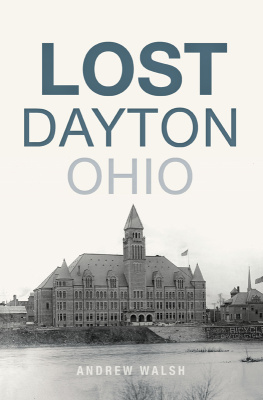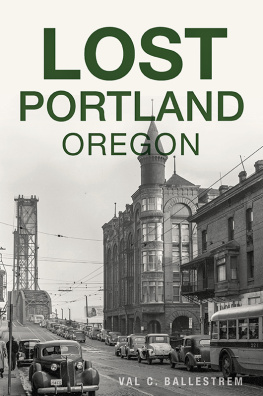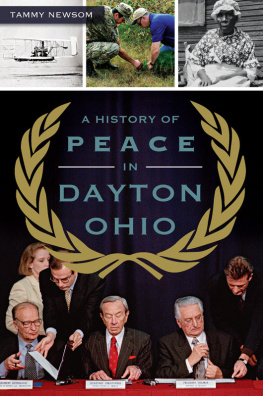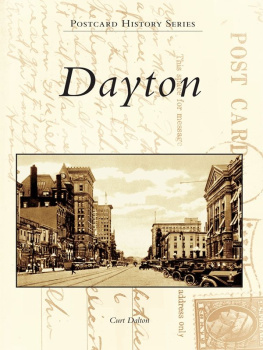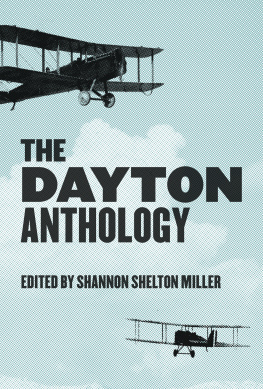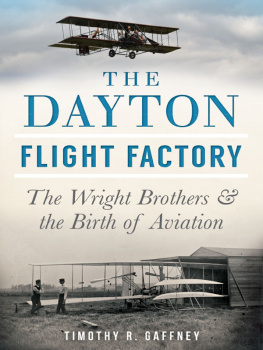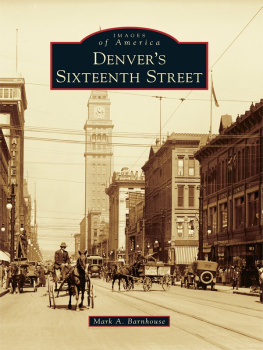


Published by The History Press
Charleston, SC
www.historypress.net
Copyright 2018 by Andrew Walsh
All rights reserved
First published 2018
e-book edition 2018
ISBN 978.1.43966.439.1
Library of Congress Control Number: 2018932112
print edition ISBN 978.1.62585.909.9
Notice: The information in this book is true and complete to the best of our knowledge. It is offered without guarantee on the part of the author or The History Press. The author and The History Press disclaim all liability in connection with the use of this book.
All rights reserved. No part of this book may be reproduced or transmitted in any form whatsoever without prior written permission from the publisher except in the case of brief quotations embodied in critical articles and reviews.
CONTENTS
PREFACE
In its heyday, Dayton, Ohio, was a center of ingenuity, innovation and invention, and the things made here, in a relatively small city in the center of the United States, changed the world. Many of the places that helped make Dayton great have been lost to history, while others have survived and adapted, representing the citys spirit of revitalization. Some of Daytons distinctive and significant structures, such as Steele High School and the Callahan Building, were demolished, while others, including the Arcade and Centre City Building, saw hard times but now await redevelopment. Entire neighborhoods and commercial districts, such as the Haymarket and West Fifth Street, have vanished and show no traces of their past, while others, including the now-popular Oregon District, narrowly escaped the wrecking ball. Major manufacturers facilitated Daytons early growth but later departed, leaving behind abandoned buildings and thousands of jobless workers. Other sites, including the Wright Brothers Factory and Huffman Prairie Flying Field, dont look like much today but once played a vital role in Daytons legacy as a pioneer of aviation and national defense. And how many dont realize that the first NFL game was played right here in Dayton at Triangle Park? This book explores a diverse selection of retail, industrial, entertainment and residential sites that have passed Dayton byas well as the influential people who shaped themand reflects on the lasting impact they made on the city.
ACKNOWLEDGEMENTS
There are many people I want to thank for their help in making this book a reality. I thank the whole History Press team for their diligent work and guidance, including Ben Gibson, Abigail Fleming, Jonny Foster and Krista Slavicek, for initially showing interest in my ideas. As I was first immersing myself in Dayton history, Curt Daltons many books on Dayton (as well as the countless resources he has put online) provided much inspiration, and upon meeting him, his advice and support were incredibly helpful. Aside from officially published works, a former UrbanOhio forum poster and blogger I know only as Jefferey inspired me with many well-researched posts that went into painstaking detail on many aspects of Dayton history. I also want to thank Bill Stolz and Dawne Dewey at Wright States Archives and Special Collections; Nancy Horlacher at Dayton Metro Librarys Dayton Room; John Gower at CityWide Development; Jon White at the City of Dayton; and Bob Smith at Sinclair for their discussions and help, along with countless other Daytonians with whom Ive talked Dayton history and development over the last few years.
I also wish to thank my family for their help and encouragement. My parents provide a formidable support team, as my mother, Barbara, is an experienced editor and my father, Timothy, an accomplished writer. I first thank my mother for taking the time to review drafts and answer my many questions when I know she was juggling many of her own work projects. My father has inspired my writing ever since I helped him write his dissertation on many early mornings when I was a baby. And although Im a first-generation Daytonian, I want to acknowledge my grandfather, the prolific writer John Evangelist Walsh, who researched Dayton extensively in the 1970s for a book on the Wright brothers published in 1975. As I was growing up, seeing him conduct research to write a seemingly endless series of books did much to awaken those same tendencies in me. I also want to thank my wife, Lillie, for standing beside me throughout this whole process and offering endless support.
INTRODUCTION
Im not a native of Dayton, Ohio, but Ive come to love the city since moving here in 2013. My interest in local history was, in part, inspired simply by looking around at the surroundings outside my apartment in the Dayton Towers complex just outside of downtown. Out of my sixth-story, west-facing window, I could see the popular Oregon District, Daytons earliest neighborhood still standing. On the eastern side of my building sat St. Annes Hill, an area contained in Daytons original east out-lots from 1815 and the location of stately mansions and well-preserved mid-nineteenth-century housing stock. But in the middle of these two historic neighborhoods was something much different: drab single-story storefronts, wide-open green spaces and two large apartment towers, including my own. I wondered what development trends resulted in this unusual arrangement.
After I learned the story of what once stood on the grounds of my apartment building, I became fascinated by the ways in which Dayton has been radically transformed over the decades: buildings gone, neighborhoods vanished, industries decimated. The more I researched, the more interesting stories I discovered. It quickly became apparent that the concept of Lost Dayton had enough material to fill several volumes, so the question of selection came into play. I have attempted to choose a series of sitesbe they commercial buildings, factories, parks or schoolsthat represent larger themes in Daytons history and involve some of its notable figures. Some sites are considered among Daytons most prominent buildings, while others are somewhat lesser known but illustrative of something of great value to the city. I use lost to mean either demolishedas many of the sites areor significantly transformed so that a locations original purpose has been largely forgotten. Many of the chapter sites interrelate, and one common thread is the Great Flood of 1913, which wreaked havoc on the core of the city of Dayton and devastated many of the sites explored in this book. Although the community rallied and rebuilt, additional forces such as suburbanization, deindustrialization and others forced Dayton to greatly adapt in order to cling to survival. The result today is a Dayton that has lost a significant portion of its character but one that has taken major steps toward reinvention for a new era and will continue to do so in the coming years.

The Great Flood of 1913 was devastating for many sites explored in this book. Courtesy of Dayton Metro Library.
PART I
NEIGHBORHOODS
BOMBERGER PARK
(The Haymarket, St. Annes Hill)
The appearance of Daytons Bomberger Park on the near east side has changed greatly over the years, but you can still stand at the top of the hill and gaze out over downtown. What you see in the foreground today, however, is completely unrecognizable from what was there before, as the area represents one of Daytons most ambitious efforts to radically change the character of the city. Daytons urban renewal in the 1960s destroyed a once bustling neighborhood that sat in between the Oregon District and St. Annes Hill, two of Daytons oldest surviving neighborhoods. And without a valiant effort at the dawn of the nationwide historic preservation movement, the losses could have been much more drastic.
Next page
